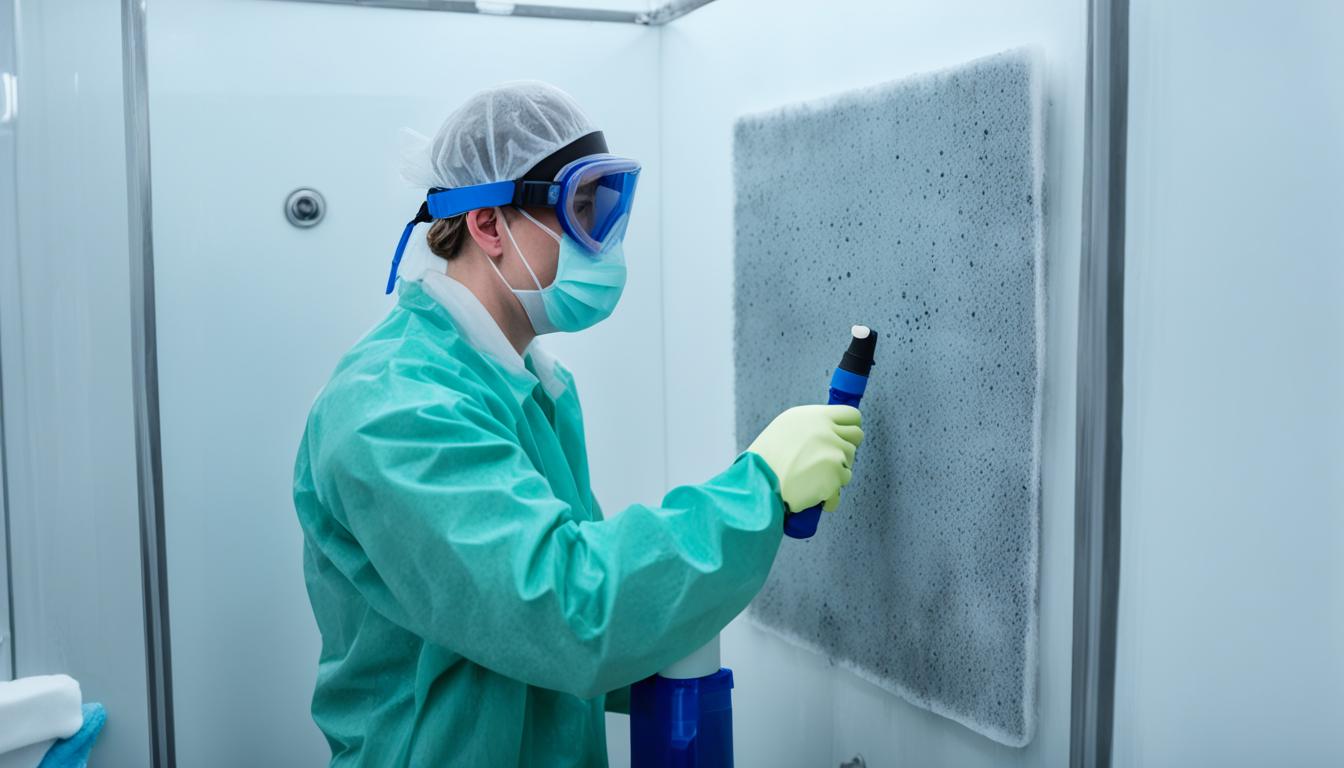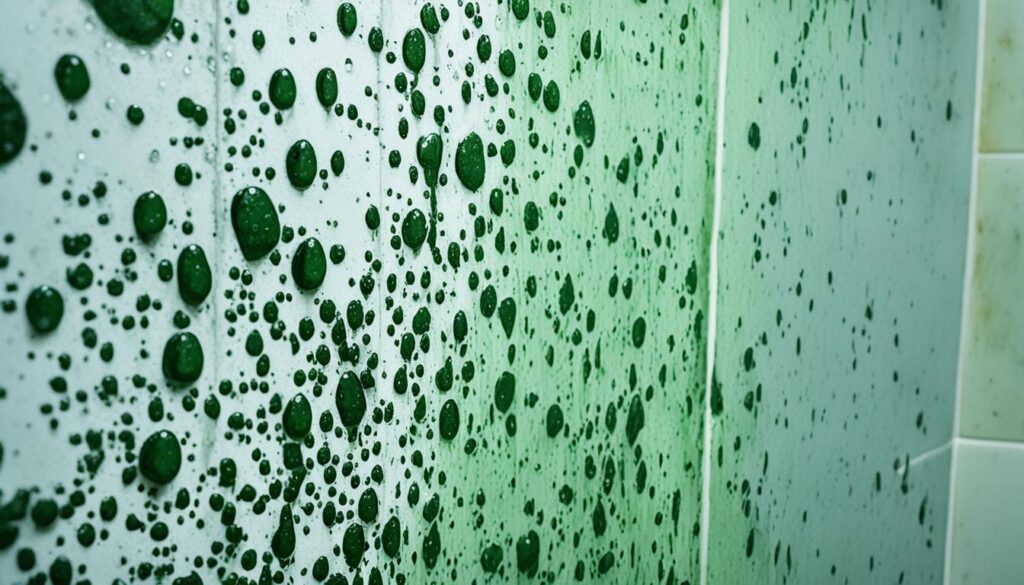
Eradicate Mold: Clean Behind Shower Panels Safely
Mold growth in the bathroom can be a persistent and unsightly problem. If left untreated, it can affect the air quality and pose health risks. One area where mold often hides is behind shower panels. Cleaning mold from this hidden space requires specific techniques to ensure a thorough removal without damaging the panels.
If you’re wondering, “How can I clean mold from behind shower panels?”, you’ve come to the right place. In this section, we will explore expert techniques and tips for safely removing mold behind shower panels. With the right approach, you can effectively eradicate mold, ensuring a clean and healthy shower space for you and your family.
Key Takeaways:
- Regularly inspect and clean your shower space to prevent mold growth behind panels.
- Implement preventive measures like proper ventilation and reducing moisture in the bathroom.
- Use appropriate cleaning solutions and tools to safely remove mold from behind shower panels.
- Follow recommended safety precautions, such as wearing protective gear, when cleaning mold.
- Maintain a clean and mold-free bathroom environment through consistent shower maintenance.
Preventing Mold Growth and Shower Maintenance
To maintain a clean and mold-free bathroom environment, it is essential to implement preventive measures and regular shower maintenance. By following these mold cleaning tips, you can effectively minimize the growth of mold behind shower panels and ensure a healthy space for your daily routines.
Preventive Measures
“An ounce of prevention is worth a pound of cure.”
– Benjamin Franklin
Preventing mold growth begins with creating an environment that is inhospitable to mold spores. Here are some preventive measures that can significantly reduce the chances of mold development:
- Proper ventilation: Ensure adequate airflow in your bathroom by using exhaust fans or opening windows after showering. This helps to remove dampness and reduce moisture levels.
- Regular cleaning: Keep your shower and bathroom clean and dry by wiping down surfaces, including shower panels, walls, and floors, regularly. This removes any moisture that can contribute to mold growth.
- Good insulation: Insulate your bathroom walls and shower panels to prevent condensation and moisture buildup. This reduces the potential for mold formation in hidden areas.
- Sealant maintenance: Inspect and maintain the sealant around your shower panels to prevent water leaks. Damaged or deteriorating sealant can allow moisture to seep through, creating a favorable environment for mold.
Shower Maintenance Tips
In addition to preventive measures, regular shower maintenance is vital to prevent the growth of mold behind shower panels. Here are some essential tips to keep your shower area clean and mold-free:
- Remove soap scum and residue: Soap scum and residue can provide a breeding ground for mold. Regularly clean your shower panels and surfaces using a mild detergent or cleaner to prevent buildup.
- Dry shower surfaces: After each use, wipe down your shower panels, walls, and floors with a dry cloth or squeegee to remove excess moisture. This helps to prevent mold growth by eliminating the dampness that mold thrives on.
- Regularly inspect for leaks: Check for any signs of leaks or water damage behind your shower panels. Addressing leaks promptly prevents moisture buildup and minimizes the risk of mold formation.
- Replace worn-out grout and caulk: Damaged or deteriorating grout and caulk provide openings for water penetration. Regularly inspect and replace any worn-out grout or caulk around your shower panels to maintain a watertight seal.
By incorporating these preventive measures and shower maintenance tips into your bathroom routine, you can significantly reduce the chances of mold growth behind shower panels. A healthy and mold-free shower space not only promotes hygiene but also contributes to a pleasant bathing experience.

| Preventive Measures | Shower Maintenance Tips |
|---|---|
| Proper ventilation | Remove soap scum and residue |
| Regular cleaning | Dry shower surfaces |
| Good insulation | Regularly inspect for leaks |
| Sealant maintenance | Replace worn-out grout and caulk |
Effective Mold Removal Techniques
Mold growth behind shower panels can be a troublesome issue that requires prompt attention. To ensure thorough mold removal and maintain a clean and healthy bathroom environment, it is essential to follow effective techniques. In this section, we will provide step-by-step instructions and recommended cleaning solutions for eliminating mold from behind shower panels.
Step 1: Prepare
Prior to starting the mold removal process, it is important to take proper safety precautions. Make sure to wear protective gloves, safety goggles, and a mask to prevent exposure to mold spores. Open windows or provide adequate ventilation to minimize the spread of mold spores.
Step 2: Identify the Mold Problem
Before proceeding with mold removal, identify the extent of the mold growth. If the affected area is larger than 10 square feet, it is recommended to seek professional assistance. For smaller areas, you can proceed with DIY mold removal techniques.
Step 3: Use an Effective Cleaning Solution
Select a suitable cleaning solution for mold removal. There are various options available, including commercial mold cleaners, bleach solutions, vinegar, or hydrogen peroxide. Each solution has its own advantages and disadvantages, so choose the one that works best for you.
Note: Avoid using bleach on porous surfaces, as it can kill surface mold but may not penetrate deeper layers.
Step 4: Scrub and Remove Mold
Apply the chosen cleaning solution onto the mold-affected areas. Use a scrub brush or sponge to gently scrub the surface and remove the mold. Make sure to reach into corners and crevices to ensure thorough cleaning.
Tip: For stubborn mold stains, you can use a mixture of baking soda and water to create a paste. Apply the paste to the stains and let it sit for a few minutes before scrubbing.
Step 5: Rinse and Dry
After scrubbing, thoroughly rinse the area with clean water to remove any residual cleaning solution or mold debris. Use a clean cloth or towel to dry the surface completely. Ensuring proper drying will help prevent future mold growth.

Step 6: Preventing Future Mold Growth
To prevent future mold growth behind shower panels, it is important to address the root cause. Ensure proper ventilation in the bathroom by using exhaust fans or opening windows during showers. Regularly inspect the area for any signs of moisture or leaks and promptly address them.
Step 7: Regular Maintenance
Maintain a clean and moisture-free shower space by regularly cleaning and drying the shower panels. Use mold-resistant materials for shower panel construction and consider applying mold-resistant sealant to further prevent mold growth.
Remember, consistent maintenance and proactive measures are key to keeping your bathroom mold-free.
| Product | Advantages |
|---|---|
| Commercial Mold Cleaners | – Specifically formulated for mold removal – Effective against various types of mold – Convenient to use |
| Bleach Solutions | – Strong disinfectant – Affordable option – Widely available |
| Vinegar | – Natural and non-toxic – Effective against some types of mold – Safe for use on various surfaces |
| Hydrogen Peroxide | – Kills mold effectively – Non-toxic and safe to use – Can be used on different surfaces |
By following these effective mold removal techniques and implementing preventive measures, you can effectively eliminate mold from behind shower panels and maintain a clean, safe, and mold-free bathroom environment.
Conclusion
In conclusion, it is crucial to address mold growth behind shower panels through proper cleaning and maintenance. Regular inspection and cleaning of your shower space, along with the implementation of preventive measures, are essential to keeping your bathroom mold-free. By using the right techniques and products, you can effectively eliminate mold and create a healthy living environment.
Mold growth in the bathroom can lead to various health problems and weaken the structural integrity of your shower panels. Therefore, it is vital to prioritize regular cleaning and maintenance to prevent mold from developing and spreading.
Remember to use appropriate cleaning solutions, such as bleach or vinegar, and follow the manufacturer’s instructions for any cleaning products. Additionally, ensure proper ventilation in your bathroom to reduce moisture and humidity levels, as mold thrives in damp environments.
By taking proactive steps to prevent and address mold growth behind shower panels, you can maintain a clean and hygienic bathroom, promoting a healthier living space for you and your family.




